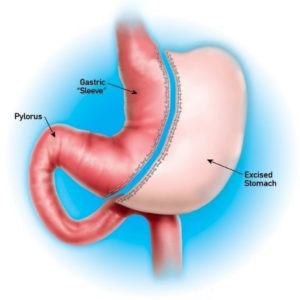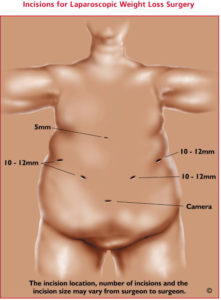
Laparoscopic Sleeve Gastrectomy
The laparoscopic sleeve gastrectomy is a restrictive procedure in which 85-90 % of the volume of the stomach is removed, but the gastric sleeve and the rest of the GI tract are in continuity. Nothing is bypassed. And the sleeve is not a device, like the lap band, but the new tubular shape of your stomach. In Dr. Suggs experience, the sleeve has similar results to the gastric bypass. It’s even pretty effective in curing or relieving diabetes. It’s very effective in improving or curing high blood pressure, sleep apnea, asthma, heart disease, joint pain, and acid reflux. The surgery is performed laparoscopically through tiny incisions, and most people go home from the hospital the day after surgery. Most patients are back to work in 1-2 weeks, but often in less time. Dr. Suggs has performed >1500 laparoscopic sleeves.

How it works
- Originated with the duodenal switch operation, a 2 part operation
- Surgeons found that weight loss was so good with the sleeve operation, that they did not need to do the 2nd operation (the switch)
- Now the most common bariatric operation in the US
- Rapid initial weight loss*
- Stomach with intact pylorus
- If a patients has a hiatal hernia, that is also corrected during the sleeve surgery
- Eliminates a portion of the stomach that produces Ghrelin
- Minimizes ulcers, risk of intestinal obstruction (blockage), anemia, osteoporosis, protein deficiency and vitamin deficiency
Advantages
- Rapid initial weight loss
- Stomach with intact pylorus
- Eliminates a portion of the stomach that produces Ghrelin
- Minimizes ulcers, risk of intestinal obstruction (blockage), anemia, osteoporosis, protein deficiency and vitamin deficiency
- Can be converted to almost any other weight loss procedure

Results
- Average of 70% excess weight loss*
- >50% excess weight loss long term*
- Fastest weight loss in 1st 6 months
- The more obese you are, the faster the loss
- The older you are, the slower the loss
- Weight loss stabilizes at 18 months with small regain
- You lose fat but not skin
- Generally, not hungry
Risks
As with any surgery, there can be risks like leak from the staple line (<0.15%), risk of infection (<0.5%), bleeding (<1%), and pulmonary embolism (<1.0%). There’s also the risk of the sleeve being too tight, which could result in nausea and the need to stay on liquids for a couple of months after surgery. Some patients may have temporary hair loss while rapidly losing weight.
Qualifications:
- BMI 30-34 with comorbidities and or a BMI 35+ no comorbidities necessary.
- Age 18-70 years
- Smoke-free for at least 2 months prior to surgery and a commitment to stay smoke –free.
- Previous failed attempts at dieting.
Insurance Coverage:
- If your insurance covers bariatric surgery, they should also cover the laparoscopic sleeve gastrectomy. However, the BMI criteria may vary per insurance requirements. Note that you will have copays and deductibles.
- Note that most insurances also have additional requirements for approval for surgery, such as 6-months of physician supervised diet, 3 years of primary care physician records, and psychology clearance.
- For those whose insurance does not cover bariatric surgery, the total cost (all-inclusive) is as low as $9,995.
Our Patients
Before

After

Before

After

